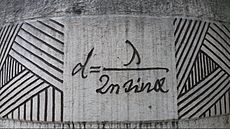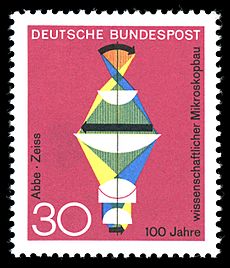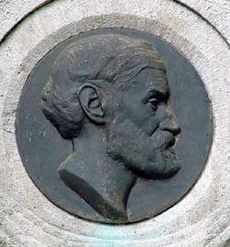Ernst Abbe facts for kids
Quick facts for kids
Ernst Abbe
|
|
|---|---|
| Born | 23 January 1840 |
| Died | 14 January 1905 (aged 64) |
| Nationality | German |
| Alma mater | |
| Known for |
|
| Scientific career | |
| Fields | Physicist |
| Institutions | University of Jena |
| Doctoral advisor |
|
| Doctoral students | Heinrich Friedrich Weber |
| Other notable students | Gottlob Frege |
Ernst Karl Abbe (born January 23, 1840 – died January 14, 1905) was an important German physicist and optical scientist. He was also an entrepreneur and a social reformer.
Ernst Abbe worked with Otto Schott and Carl Zeiss to create many new optical tools. He was also a co-owner of Carl Zeiss AG. This German company makes scientific microscopes, telescopes, and other advanced optical systems.
Contents
Early Life and Education
Ernst Abbe was born on January 23, 1840, in Eisenach, Germany. His family was not wealthy; his father worked as a foreman in a spinning factory. With help from his father's employer, Ernst was able to go to high school. He graduated in 1857 with good grades.
Ernst's talent for science was clear early on. Even though his family didn't have much money, his father supported him to study at the University of Jena (1857–1859) and the University of Göttingen (1859–1861). To help pay for his studies, Ernst gave private lessons. He earned his PhD from Göttingen in 1861.
In 1863, he became a university lecturer at the University of Jena. By 1870, he was an associate professor of experimental physics, mechanics, and mathematics in Jena. In 1871, he married Else Snell, who was the daughter of one of his teachers, Karl Snell. They had two daughters. Ernst became a full professor in 1879. He also became the director of the Jena Observatory in 1878.
Amazing Work in Optics
In 1866, Ernst Abbe became a research director at the Zeiss Optical Works. This was a big step in his career. At Zeiss, he made many important inventions and discoveries that changed how we see tiny things.
Key Inventions and Discoveries
- Apochromatic Lens: In 1886, he invented the apochromatic lens. This special microscope lens helps to remove color distortions, making images much clearer.
- Abbe Condenser: By 1870, Abbe invented the Abbe condenser. This part of a microscope helps to light up the object you are looking at, making it easier to see details.
- Refractometer: In 1871, he designed the first Abbe refractometer. This tool measures how light bends when it passes through different materials.
- Laws of Image Formation: By 1872, he developed important rules about how images are formed by non-luminous (not glowing) objects.
Zeiss Optical Works quickly started selling microscopes with Abbe's improvements. By 1872, they were selling his better microscopes. In 1877, they offered microscopes with "homogenous immersion objectives," and by 1886, his advanced apochromatic objective microscopes were available.
Understanding Light and Vision
Ernst Abbe also created the Abbe number. This number measures how much a transparent material's refractive index changes with different colors of light. This is important for designing lenses that work well.
He also defined the term numerical aperture. This is a number that describes how much light a lens can gather. It's very important for how clear and detailed a microscope's image can be.
Abbe is famous for figuring out the resolution limit of a microscope. This is the smallest detail a microscope can show clearly. He published a formula for this in 1873:
Template:Repeat/0
|
|
|
( |
Template:Repeat/0
This formula shows that the smallest detail you can see (d) depends on the wavelength of light (λ) and the numerical aperture (NA) of the lens. Basically, the wider the lens opening (aperture), the more detail you can see.
Even though others had thought about this formula before, Abbe was the first to prove it experimentally. In 1878, he built the first "homogenous immersion system" for microscopes, which helped to improve image quality even more.
Improving Lenses and Glass
Abbe made big steps in fixing problems with lenses, like spherical aberration and coma aberration. These problems can make images blurry or distorted. His work helped lenses reach their maximum possible clarity.
He also discovered the Abbe sine condition. This principle is crucial for designing high-quality optical systems that produce sharp, clear images. His calculations were so advanced that later scientists, like Frits Zernike (who won a Nobel Prize for his work on phase contrast) and Hans Busch (who worked on the electron microscope), used Abbe's ideas as a base for their own discoveries.
In 1884, Abbe, Carl Zeiss, Zeiss' son Roderich, and Otto Schott started a new company called Jenaer Glaswerk Schott & Genossen. This company focused on researching and producing new types of optical glass, which was essential for making even better lenses.
Social Reforms
Ernst Abbe was not just a brilliant scientist; he was also a caring social reformer. He believed in fair treatment for workers.
- In 1890, he started the Jenaische Zeitung, a newspaper that supported social democratic ideas.
- In 1900, he introduced the eight-hour workday at the Zeiss factory. This was a huge change, as many people worked 14 hours a day back then, including his own father.
- He also created a pension fund and a fund to help workers if they lost their jobs.
In 1889, Ernst Abbe set up the Carl Zeiss Foundation. He gave a lot of his own money to this foundation. Its goal was to make sure the company would be strong in the future and to improve job security for its employees. He made sure that an employee's success was based only on their skills and performance, not on their background, religion, or political beliefs. In 1896, he changed the Zeiss optical works into a cooperative, where employees shared in the company's profits.
Abbe's ideas about social fairness were so respected that the Prussian state used them as a model for other businesses.
The crater Abbe on the Moon is named in his honor.
See also
 In Spanish: Ernst Abbe para niños
In Spanish: Ernst Abbe para niños
- Abbe condenser
- Abbe diffraction limit
- Abbe error
- Abbe eyepiece
- Abbe number
- Abbe prism
- Abbe refractometer
- Abbe sine condition
- Abbe–Koenig prism
- Abbe–Porro prism
- Aberration in optical systems
- Crown glass (optics)
- Dermatoscopy
- Diaphragm (optics)
- Calculation of glass properties
- Optical aberration
- Optical dilatometer
- German inventors and discoverers







